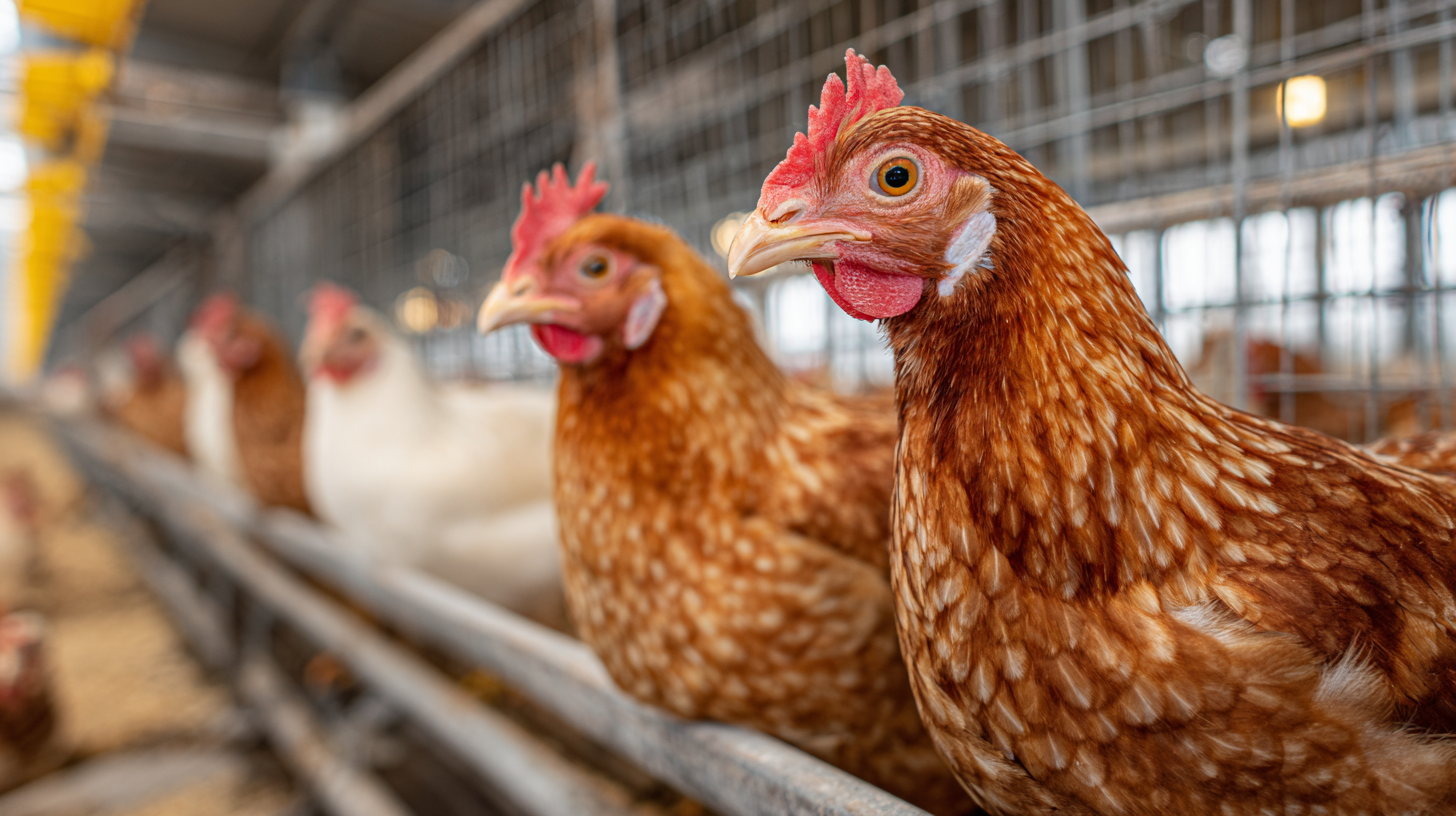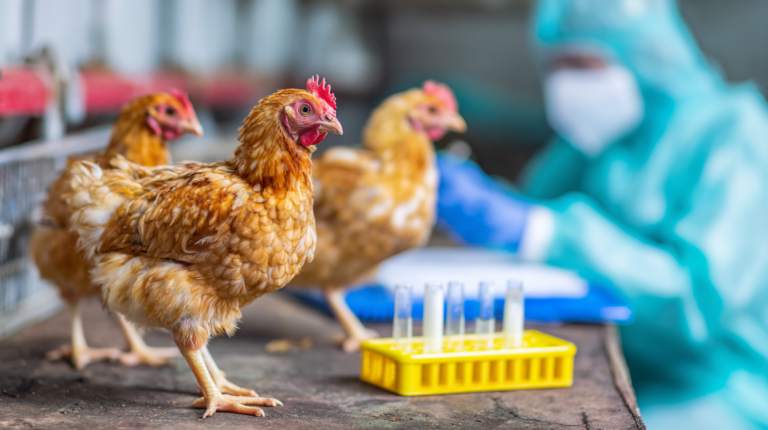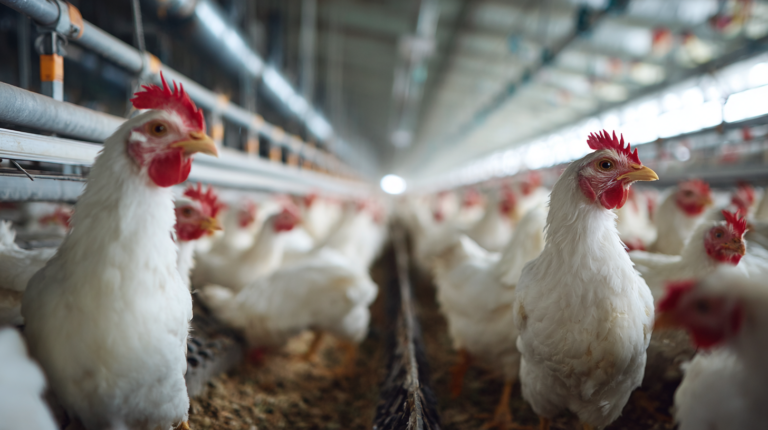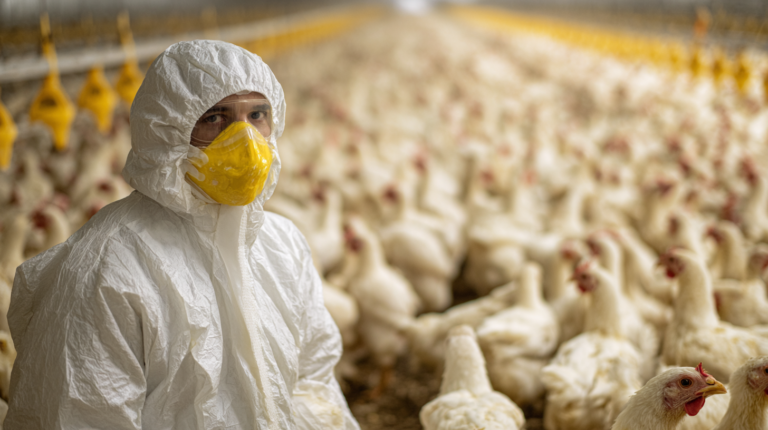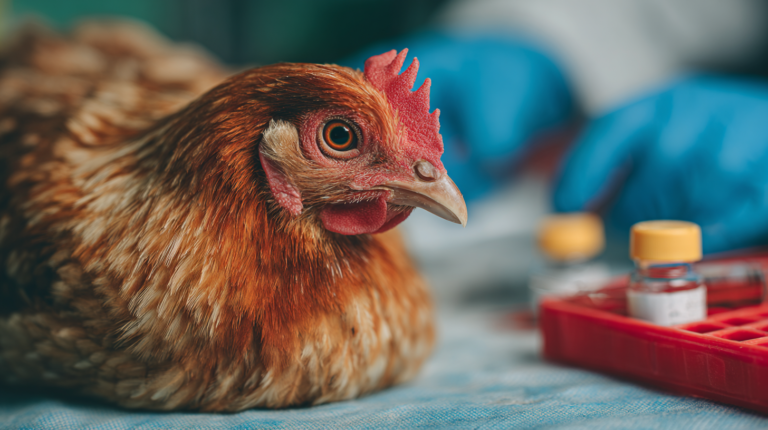Discover 5 alarming ways toxoplasmosis in poultry spreads to humans and pets. Learn prevention strategies, symptoms, and expert veterinary insights for safer poultry handling.
Table of Contents
Toxoplasmosis in poultry represents one of the most underestimated zoonotic threats in backyard farming and commercial poultry operations. This parasitic infection, caused by Toxoplasma gondii, affects millions of birds worldwide and poses significant health risks to humans, pregnant women, and immunocompromised individuals. While many poultry owners focus on common diseases like avian influenza or Newcastle disease, toxoplasmosis silently spreads through flocks, creating a hidden danger that demands immediate attention.
Recent veterinary studies indicate that up to 30% of free-range chickens may carry toxoplasmosis antibodies, suggesting widespread exposure to this parasitic infection. The concerning reality is that infected birds often show no obvious symptoms, making early detection challenging for even experienced poultry keepers. Understanding how toxoplasmosis spreads through poultry populations is crucial for protecting both your flock and your family’s health.
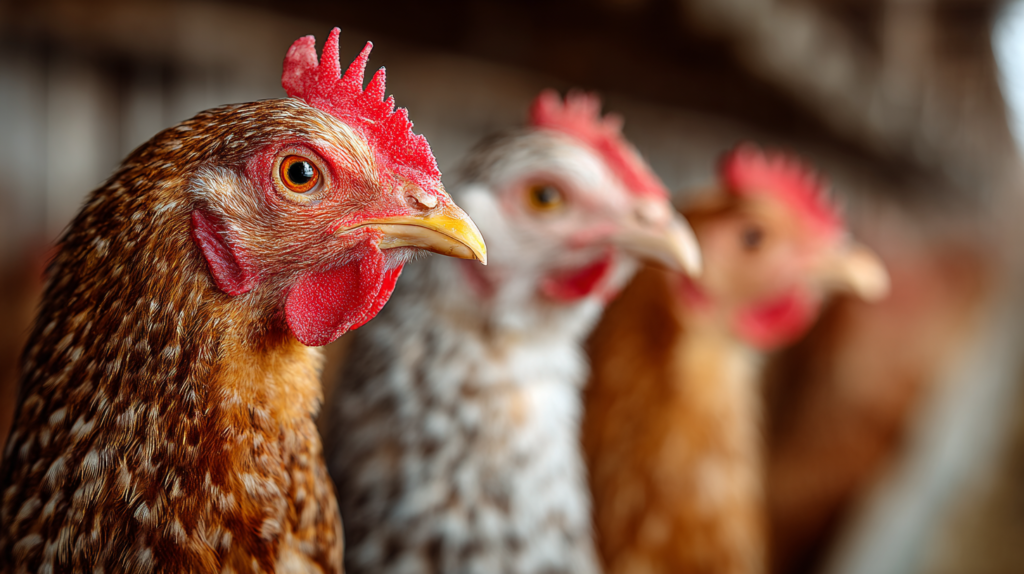
This comprehensive guide examines five alarming transmission pathways that every poultry owner should understand. From contaminated feed sources to improper waste management, these transmission routes create opportunities for this dangerous parasite to infiltrate your flock and potentially reach your dinner table. By recognizing these risks and implementing proper prevention strategies, you can significantly reduce the likelihood of toxoplasmosis affecting your poultry operation.
Understanding Toxoplasmosis in Poultry:
| Transmission Pathway | Risk Level | Common Sources | Prevention Methods |
|---|---|---|---|
| Contaminated Feed & Water | High | Oocyst contamination from cat feces, untreated water sources | Covered feed storage, treated water systems, regular cleaning |
| Feline Contamination | High | Cat feces in poultry areas, contaminated litter | Cat exclusion barriers, immediate feces removal |
| Contaminated Soil | Medium | Oocysts in soil, environmental persistence | Soil treatment, rotation systems, drainage management |
| Infected Prey Animals | Medium | Rodents, birds, insects carrying tissue cysts | Pest control programs, secure housing systems |
| Human-Mediated Transmission | Low | Contaminated equipment, footwear, clothing | Strict biosecurity protocols, disinfection procedures |
Toxoplasmosis in poultry occurs when birds become infected with Toxoplasma gondii, a microscopic parasite that completes its life cycle primarily in cats but can infect virtually all warm-blooded animals. In poultry, this infection often remains subclinical, meaning birds appear healthy while harboring the parasite in their muscle tissue and organs.
The parasite exists in three forms: sporozoites, tachyzoites, and bradyzoites. Each form plays a different role in the transmission cycle and presents unique challenges for poultry health management. Sporozoites are found in cat feces and contaminated environments, tachyzoites multiply rapidly during acute infection, and bradyzoites form dormant cysts in muscle tissue that can remain viable for months or even years.
Dr. Sarah Martinez, a veterinary parasitologist at the University of California Davis, explains, “Toxoplasmosis in poultry is particularly concerning because infected birds rarely show clinical signs. This silent infection can persist in muscle tissue long after the initial exposure, creating a reservoir for human infection through consumption of undercooked poultry products.”
The economic impact of toxoplasmosis extends beyond immediate health concerns. Infected flocks may experience reduced egg production, decreased feed conversion efficiency, and increased mortality rates, particularly in young birds. Commercial operations report losses of up to 15% in productivity when toxoplasmosis affects their flocks, making prevention strategies essential for both health and economic reasons.
Diagnostic challenges further complicate toxoplasmosis management in poultry. Traditional serological testing can detect antibodies indicating past exposure but cannot determine current infection status or tissue cyst burden. Advanced molecular techniques like PCR testing offer more precise detection but require specialized laboratory facilities and trained personnel.
The Five Alarming Transmission Pathways
1. Contaminated Feed and Water Sources
Feed contamination represents the most common route for toxoplasmosis transmission in poultry operations. The parasite enters feed supplies through multiple pathways, creating widespread exposure opportunities throughout entire flocks. Understanding these contamination sources is essential for implementing effective prevention strategies.
Rodent contamination poses the greatest risk to feed safety. Mice and rats infected with toxoplasmosis shed oocysts in their feces, directly contaminating stored feed. A single infected mouse can contaminate hundreds of pounds of feed, creating exposure opportunities for entire flocks. Studies show that facilities with poor rodent control experience toxoplasmosis infection rates up to 300% higher than well-managed operations.
Water source contamination occurs when cat feces containing oocysts enter drinking water systems. Surface water sources, particularly those accessible to feral cats, present significant risks. Rainwater collection systems can become contaminated when cats use roof surfaces as litter areas, concentrating oocysts in collected water. Even covered water systems can become contaminated through contaminated cleaning equipment or handler transmission.
Feed storage practices significantly influence contamination risk. Improperly sealed containers allow rodent access and fecal contamination. Moisture in storage areas creates ideal conditions for oocyst survival and sporulation. Temperature fluctuations in storage facilities can extend oocyst viability, increasing contamination persistence.
Raw ingredient contamination occurs during feed manufacturing when contaminated materials enter the production process. Fishmeal, meat meal, and other animal protein sources can harbor toxoplasmosis if sourced from infected animals. Grain contamination occurs when harvesting equipment or storage facilities become contaminated with cat feces.
Prevention strategies for feed contamination include implementing comprehensive rodent control programs, securing feed storage areas, regular cleaning of feeding equipment, and sourcing feed from reputable manufacturers with quality control programs. Water testing and treatment systems can eliminate oocysts from drinking water supplies.
2. Feline Contamination and Fecal Exposure
Cats serve as the definitive host for Toxoplasma gondii, making their presence around poultry facilities a significant risk factor for toxoplasmosis transmission. Understanding feline behavior and contamination patterns is crucial for developing effective prevention strategies.
Feral cat populations around poultry operations create persistent contamination sources. These cats hunt rodents and birds, maintaining high infection rates and continuous oocyst shedding. A single infected cat can shed millions of oocysts over several weeks, contaminating large areas around poultry facilities. Research indicates that facilities with active feral cat populations experience toxoplasmosis infection rates 400% higher than cat-free operations.
Domestic cats with outdoor access pose similar risks. Indoor-outdoor cats that hunt wildlife frequently become infected and shed oocysts in areas where poultry forage. Cat litter disposal practices can create contamination hotspots when litter is composted or disposed of near poultry areas. Even well-cared-for cats can become infected through hunting behavior or consumption of contaminated prey.
Oocyst survival in the environment extends contamination risk beyond active cat presence. In favorable conditions, oocysts remain viable for 18 months or longer, creating persistent contamination zones. Soil contamination occurs when cat feces are deposited in areas where poultry forage or where feed is stored. Weather conditions, particularly moisture and moderate temperatures, enhance oocyst survival and increase infection risk.
Vertical transmission from infected cats to their offspring maintains contamination cycles. Pregnant cats can transmit toxoplasmosis to their kittens, creating new generations of infected animals. These young cats often show no symptoms but continue shedding oocysts, perpetuating the contamination cycle around poultry facilities.
Management strategies for feline contamination include feral cat control programs, restricting cat access to poultry areas, proper litter disposal practices, and regular environmental decontamination. Physical barriers like fencing can prevent cat access to critical areas, while motion-activated deterrents can discourage cat presence around feed storage and water sources.
3. Contaminated Soil and Environmental Persistence
Soil contamination with toxoplasmosis oocysts creates long-term infection risks for poultry operations. The parasite’s remarkable environmental persistence makes contaminated soil a continuing source of exposure for foraging birds and can compromise biosecurity measures for extended periods.
Oocyst sporulation in soil creates highly infectious particles that remain viable for months or years. The sporulation process, which occurs 1-5 days after oocyst deposition, produces mature oocysts capable of causing infection. Soil pH, moisture content, and temperature all influence sporulation rates and oocyst survival. Slightly acidic soils with moderate moisture levels provide optimal conditions for oocyst persistence.
Free-range poultry operations face particular challenges from soil contamination. Birds that forage in contaminated areas consume oocysts while pecking at soil, insects, and vegetation. Dust created by scratching and foraging behavior aerosolizes oocysts, creating inhalation risks for both birds and handlers. Research shows that free-range flocks experience toxoplasmosis infection rates 250% higher than confined operations.
Agricultural contamination occurs when infected cat feces contaminate fields used for feed crop production. Farming equipment can spread oocysts across large areas, creating widespread contamination zones. Irrigation systems using contaminated water sources can distribute oocysts throughout agricultural areas. Composting practices that include cat litter or contaminated organic matter can create concentrated oocyst sources.
Seasonal variations affect oocyst survival and transmission risk. Spring and fall conditions typically favor oocyst persistence, while extreme summer heat and winter freezing can reduce viability. However, protected soil environments may maintain viable oocysts through adverse conditions. Snow cover can preserve oocysts through winter months, creating infection risks when snow melts.
Decontamination strategies for soil contamination include lime treatment to raise pH levels, proper composting with adequate temperatures, soil replacement in heavily contaminated areas, and restricted access to contaminated zones. Regular soil testing can identify contamination hotspots and guide remediation efforts.
4. Infected Prey Animals and Intermediate Hosts
Toxoplasmosis transmission through infected prey animals represents a complex pathway that affects both wild and domestic bird populations. Understanding these transmission cycles helps poultry owners recognize risk factors and implement appropriate prevention measures.
Rodent populations serve as primary intermediate hosts for toxoplasmosis around poultry facilities. Mice and rats become infected by consuming oocysts from contaminated environments and maintain chronic infections throughout their lives. These infected rodents serve as concentrated sources of parasites when consumed by cats, chickens, or other predators. Studies indicate that up to 70% of rodent populations in areas with active cat populations may harbor toxoplasmosis.
Wild bird populations contribute to toxoplasmosis transmission cycles through their role as intermediate hosts. Infected wild birds can contaminate poultry facilities through direct contact or through their droppings. Migratory birds can introduce toxoplasmosis to previously uncontaminated areas, creating new infection sources. Research shows that wild bird populations in urban and suburban areas have significantly higher toxoplasmosis infection rates than those in rural environments.
Insect vectors play an underappreciated role in toxoplasmosis transmission. Cockroaches, flies, and other insects can mechanically transport oocysts from contaminated areas to feed and water sources. These insects can survive toxoplasmosis infection and serve as mobile contamination sources. Insect control programs must consider toxoplasmosis prevention in addition to other pest management objectives.
Scavenging behavior in poultry increases exposure risk to infected prey animals. Free-range chickens that consume infected rodents or insects can become infected through predation. This natural behavior creates ongoing exposure risks that are difficult to control through management practices alone. Confinement systems reduce but do not eliminate exposure through prey consumption.
Carnivorous pet exposure represents another transmission pathway. Dogs and cats that hunt infected prey animals can become infected and potentially transmit toxoplasmosis to poultry through environmental contamination. Pet management practices should consider toxoplasmosis prevention, particularly for animals with access to poultry areas.
Prevention strategies for prey animal transmission include comprehensive pest control programs, wild bird deterrents, insect management systems, and controlled foraging practices. Regular monitoring of prey animal populations can identify infection trends and guide prevention efforts.
5. Human-Mediated Transmission and Biosecurity Failures
Human activities often facilitate toxoplasmosis transmission in poultry operations through inadequate biosecurity practices and contaminated equipment. Understanding these human-mediated risks is essential for developing comprehensive prevention programs.
Equipment contamination occurs when tools, vehicles, and machinery transfer oocysts between contaminated and clean areas. Tractors, feed delivery vehicles, and maintenance equipment can carry contaminated soil and debris between facilities. Cleaning equipment used in contaminated areas can spread oocysts if not properly disinfected. Research indicates that equipment-mediated transmission accounts for up to 25% of inter-facility toxoplasmosis spread.
Personnel contamination happens when workers, visitors, or service providers carry oocysts on clothing, footwear, or equipment. Inadequate hand washing and sanitization practices allow oocyst transmission from contaminated surfaces to feed, water, and equipment. Clothing and footwear worn in contaminated areas can transport oocysts to clean facilities. Personal protective equipment that is not properly maintained or replaced can become contamination sources.
Feed delivery contamination occurs when delivery vehicles, equipment, or personnel introduce oocysts during feed transport and storage. Contaminated feed trucks can spread oocysts between multiple facilities during delivery routes. Improper feed handling practices during delivery can contaminate previously clean feed storage areas. Studies show that facilities receiving feed from contaminated delivery systems experience infection rates 200% higher than those with secure delivery protocols.
Visitor contamination represents an often-overlooked transmission pathway. Veterinarians, extension agents, and other visitors can carry oocysts between facilities on clothing, equipment, or vehicles. Educational tours and farm visits can introduce contamination from urban areas with high cat populations. Inadequate visitor protocols allow contamination introduction despite other biosecurity measures.
Waste management failures create opportunities for toxoplasmosis transmission through improper disposal of contaminated materials. Poultry litter that contains oocysts can contaminate new areas when spread as fertilizer. Composting practices that fail to achieve adequate temperatures may preserve oocysts in finished compost. Improper disposal of dead birds or contaminated bedding can create persistent contamination sources.
Biosecurity protocols for human-mediated transmission include comprehensive sanitation procedures, visitor management systems, equipment disinfection protocols, and personnel training programs. Regular audit of biosecurity practices can identify weaknesses and guide improvement efforts.
Visual Elements: The infographic displays a central chicken silhouette surrounded by five distinct transmission pathway illustrations. Each pathway shows specific contamination sources and prevention measures. Color-coded arrows indicate transmission direction and risk levels. Prevention strategies are highlighted in green boxes adjacent to each risk factor.
Clinical Signs and Diagnosis of Toxoplasmosis in Poultry
| Age Group | Clinical Signs | Severity | Duration | Additional Notes |
|---|---|---|---|---|
| Young Chicks (0-4 weeks) | Neurological signs, tremors, paralysis, poor coordination | Severe | 1-2 weeks | Most susceptible age group, high mortality rate |
| Growing Birds (4-12 weeks) | Reduced growth, respiratory distress, lethargy | Moderate | 2-3 weeks | May show subclinical infections |
| Adult Layers | Decreased egg production, poor feed conversion | Mild | Variable | Often asymptomatic, chronic infections common |
| Breeding Stock | Reduced fertility, embryonic mortality | Moderate | Ongoing | Can affect reproductive performance long-term |
| Broilers | Poor weight gain, increased feed conversion ratio | Variable | Production cycle | Economic impact through reduced efficiency |
| All Ages | Often asymptomatic, subclinical infections | Mild | Lifelong | Tissue cysts remain viable, food safety concern |
Recognizing toxoplasmosis in poultry presents significant challenges due to the often subclinical nature of the infection. Most infected birds appear healthy and continue normal activities while harboring the parasite in their tissues. However, understanding potential clinical signs and diagnostic approaches is essential for effective flock management.
Acute toxoplasmosis in poultry may present with neurological symptoms including head tremors, circling behavior, and loss of coordination. Affected birds may exhibit depression, reduced appetite, and difficulty maintaining balance. These symptoms are most commonly observed in young birds or those with compromised immune systems. Mortality rates in acute cases can reach 30% in susceptible populations.
Chronic toxoplasmosis typically presents with subtle performance indicators rather than obvious clinical signs. Infected flocks may experience reduced egg production, with decreases of 10-15% in laying hens. Feed conversion efficiency may decline, leading to increased production costs. Growth rates in meat birds may be reduced, affecting market weight achievement timelines.
Reproductive impacts include increased embryonic mortality and reduced hatchability in breeding flocks. Infected hens may produce eggs with higher rates of developmental abnormalities. Fertility rates can be affected in both hens and roosters, leading to decreased reproductive success. These reproductive impacts can persist for months after initial infection.
Diagnostic testing for toxoplasmosis in poultry requires specialized laboratory techniques. Serological testing can detect antibodies indicating past or current exposure but cannot determine tissue cyst burden or infection status. ELISA testing is commonly used for flock screening and can provide rapid results for management decisions. PCR testing offers more specific detection but requires fresh tissue samples and specialized laboratory facilities.
Post-mortem examination may reveal tissue cysts in muscle and organ samples from infected birds. Histopathological examination can identify characteristic lesions and inflammatory responses associated with toxoplasmosis. However, many infected birds show no gross lesions, making diagnosis challenging without laboratory confirmation.
Treatment options for toxoplasmosis in poultry are limited and generally not economically feasible for commercial operations. Antiprotozoal medications may reduce parasite burden but cannot eliminate tissue cysts. Prevention through management practices remains the most effective approach for controlling toxoplasmosis in poultry flocks.
Prevention Strategies and Best Practices
| Timeline Phase | Diagnostic Method | Accuracy Rate | Cost Estimate | Treatment Options |
|---|---|---|---|---|
| Day 1-3: Initial Assessment | Clinical examination, flock history review | 30-40% | $50-100 | Supportive care, isolation of affected birds |
| Day 3-7: Laboratory Testing | Serological testing (ELISA), blood samples | 70-85% | $200-400 | Targeted antimicrobial therapy if indicated |
| Day 7-14: Confirmation | PCR testing, tissue examination | 90-95% | $300-600 | Specific treatment protocols, flock management |
| Week 2-4: Monitoring | Follow-up serology, clinical assessment | 85-90% | $150-300 | Continued treatment, prevention measures |
| Month 1-3: Long-term | Periodic testing, production monitoring | 75-80% | $100-250 | Biosecurity enhancement, preventive protocols |
| Ongoing: Prevention | Regular screening, environmental testing | 80-90% | $75-200 | Continuous prevention, facility management |
Developing comprehensive prevention strategies for toxoplasmosis in poultry requires a multi-faceted approach addressing all potential transmission pathways. Effective prevention programs combine environmental management, biosecurity protocols, and regular monitoring to minimize infection risk.
Cat control represents the cornerstone of toxoplasmosis prevention in poultry operations. Implementing feral cat management programs can significantly reduce environmental contamination. Trap-neuter-return programs may be appropriate in some situations, while removal may be necessary in others. Physical barriers like fencing can prevent cat access to critical areas including feed storage and water sources.
Feed security protocols must address multiple contamination sources. Proper feed storage in sealed containers prevents rodent access and contamination. Regular cleaning of feed storage areas removes accumulated debris that may harbor oocysts. Sourcing feed from reputable manufacturers with quality control programs reduces contamination risk at the source.
Water management systems should include filtration and treatment components to eliminate oocysts from drinking water. Regular testing of water sources can identify contamination before it affects flock health. Covered water systems prevent environmental contamination while automatic waterers reduce human contact with potentially contaminated water.
Rodent control programs must be comprehensive and ongoing to effectively reduce toxoplasmosis transmission. Integrated pest management approaches combine exclusion, sanitation, and control methods. Regular monitoring of rodent populations helps identify control program effectiveness and guides adjustments.
Environmental decontamination requires understanding of oocyst survival characteristics and effective treatment methods. Lime treatment can raise soil pH to levels that reduce oocyst viability. Steam treatment and high-temperature composting can eliminate oocysts from organic materials. Regular cleaning and disinfection of facilities removes accumulated contamination.
Biosecurity protocols should address all potential human-mediated transmission pathways. Personnel training programs educate workers about toxoplasmosis risks and prevention measures. Visitor management systems control access and require appropriate sanitation measures. Equipment disinfection protocols prevent contamination transfer between areas and facilities.
Monitoring and surveillance programs enable early detection of toxoplasmosis in poultry flocks. Regular serological testing of representative birds can identify infection trends. Environmental sampling can detect contamination sources before they affect flock health. Record keeping systems track prevention program effectiveness and identify areas for improvement.
Health Risks to Humans and Pets
Toxoplasmosis in poultry presents significant health risks to humans, particularly vulnerable populations including pregnant women, immunocompromised individuals, and young children. Understanding these risks is essential for implementing appropriate safety measures in poultry operations and food handling practices.
Pregnant women face the greatest risk from toxoplasmosis exposure through poultry handling or consumption. Primary infection during pregnancy can result in congenital toxoplasmosis in the developing fetus. This condition can cause severe developmental abnormalities including hydrocephalus, cerebral calcifications, and chorioretinitis. Studies indicate that maternal infection during the first trimester poses the highest risk for severe fetal complications.
Immunocompromised individuals, including those with HIV/AIDS, cancer patients receiving chemotherapy, and organ transplant recipients, face increased risks from toxoplasmosis exposure. These populations may develop severe systemic infections including encephalitis, pneumonia, and disseminated disease. Mortality rates in immunocompromised patients can exceed 50% without appropriate treatment.
Healthy adults typically develop mild or asymptomatic infections from toxoplasmosis exposure. However, some individuals may experience flu-like symptoms including fever, muscle aches, and swollen lymph nodes. Ocular toxoplasmosis can occur in healthy adults, potentially causing vision problems or blindness. These symptoms may appear weeks or months after initial exposure.
Pet health risks include both cats and dogs that may be exposed to toxoplasmosis through contact with infected poultry or contaminated environments. Cats can develop clinical toxoplasmosis with symptoms including fever, lethargy, and neurological signs. Dogs are less susceptible but can become infected and potentially transmit the parasite to humans.
Safe handling practices for poultry products include thorough cooking to internal temperatures of 165°F (74°C) to eliminate viable parasites. Proper food preparation techniques prevent cross-contamination between raw and cooked products. Hand washing after handling raw poultry products is essential for preventing human exposure.
Personal protective equipment should be used when handling potentially infected birds or working in contaminated environments. Gloves, masks, and protective clothing reduce exposure risk during poultry care activities. Proper disposal of protective equipment prevents contamination of clean areas.
Economic Impact and Production Losses
Toxoplasmosis in poultry operations results in significant economic losses through reduced productivity, increased mortality, and additional management costs. Understanding these economic impacts helps justify investment in prevention programs and guides resource allocation decisions.
Production losses from toxoplasmosis include decreased egg production in laying hens, with reductions of 10-15% commonly reported in infected flocks. Meat production efficiency declines due to reduced growth rates and poor feed conversion. Breeding operations experience decreased hatchability and increased embryonic mortality, affecting replacement bird production.
Mortality costs vary depending on flock age and susceptibility, with young birds experiencing higher death rates. Acute toxoplasmosis outbreaks can result in mortality rates exceeding 30% in susceptible populations. Chronic infections may increase background mortality rates by 5-10% over extended periods.
Treatment and veterinary costs include diagnostic testing, medication, and professional consultation fees. While treatment options are limited, supportive care and management changes require veterinary oversight. Diagnostic testing costs can be significant for large operations requiring frequent monitoring.
Prevention program costs include infrastructure improvements, equipment purchases, and ongoing management expenses. Cat control programs require initial investment and ongoing maintenance. Feed security improvements may require storage facility upgrades and enhanced purchasing protocols.
Market access restrictions may affect operations with documented toxoplasmosis problems. Some markets require health certifications or testing protocols that increase costs. Export markets may have specific requirements for toxoplasmosis-free products.
Labor costs increase due to additional management requirements and biosecurity protocols. Personnel training programs require time and resources. Enhanced cleaning and disinfection procedures require additional labor hours.
Economic analysis of prevention programs typically shows positive returns on investment through reduced losses and improved productivity. Cost-benefit calculations should consider both direct costs and indirect benefits including reduced human health risks and improved market access.
Frequently Asked Questions
Everything you need to know about Toxoplasmosis in Poultry
No questions found matching your search. Try different keywords or browse all categories.
For more expert pet care tips and product recommendations, visit BlithePet.com — your trusted source for pet wellness.
Conclusion
Toxoplasmosis in poultry represents a serious but manageable threat to both flock health and human safety. The five transmission pathways examined in this comprehensive guide highlight the complex nature of this parasitic infection and the multiple opportunities for exposure in poultry operations. From contaminated feed sources to human-mediated transmission, each pathway requires specific prevention strategies and ongoing vigilance.
The economic impact of toxoplasmosis extends beyond immediate health concerns, affecting productivity, reproduction, and market access for poultry operations. However, the human health risks, particularly for vulnerable populations, make prevention efforts essential regardless of economic considerations. Understanding these risks empowers poultry owners to make informed decisions about management practices and safety protocols.
Effective prevention requires a comprehensive approach combining environmental management, biosecurity protocols, and regular monitoring. No single intervention can eliminate all transmission pathways, but coordinated efforts can significantly reduce infection risks. The investment in prevention programs typically provides positive returns through reduced losses and improved productivity.
Regular veterinary consultation and diagnostic testing provide essential support for toxoplasmosis prevention and management. Professional guidance helps optimize prevention strategies and ensures appropriate response to suspected infections. Ongoing education and training keep personnel informed about emerging risks and best practices.
The responsibility for toxoplasmosis prevention extends beyond individual operations to include suppliers, service providers, and regulatory agencies. Coordinated efforts throughout the poultry industry can reduce overall infection pressure and protect both animal and human health. Continued research and development of new prevention tools will enhance our ability to control this persistent threat.
By implementing the prevention strategies outlined in this guide and maintaining vigilant monitoring practices, poultry owners can protect their flocks from toxoplasmosis while ensuring the safety of their products and families. The key lies in understanding the transmission pathways, recognizing the risks, and taking proactive steps to break the infection cycle.
Have a similar experience with your pet? Share it in the comments below!

